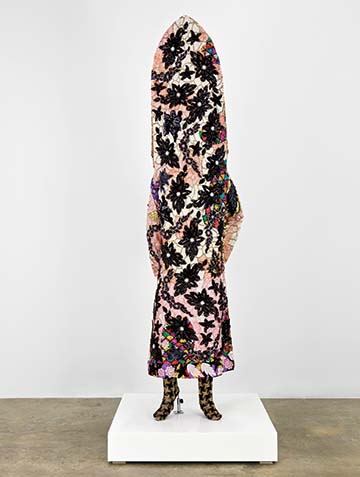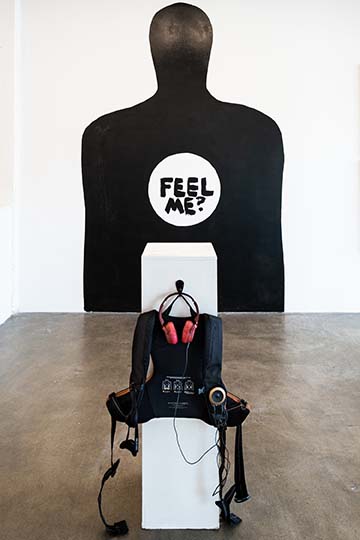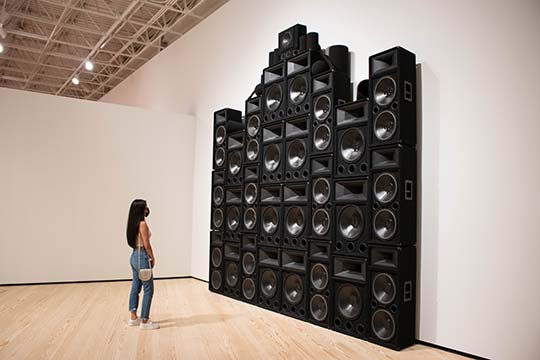When looking at sculpture, it is counterintuitive to think about the sonic properties that are latent in the materials that make up three-dimensional art, since they are not a foundational attribute of the medium. Sculptors create a visual experience which engages our sense of sight and our ability to perceive height, width, and depth. Granted, they also sometimes count on our sense of touch to fully express their ideas, as when we walk through one of Ernesto Neto’s sculptures, or on a Carl Andre floor sculpture.
Stepping beyond the three-dimensional ever so briefly, and moving closer to the sonic, there is sometimes an invitation (or maybe a temptation) to thump, as when we select our favorite melons at market, in order to get a sense of what material sounds like. I have participated in, and observed, this kind of sonic curiosity. Hang around any of Richard Serra’s Cor-Ten steel sculptures long enough, and it is bound to happen. At the Modern Art Museum of Fort Worth, Serra’s Vortex, a vertical steel sculpture acquired by the museum in 2002, is a site where many curious art enthusiasts do that exact thing. Standing in the center of the vortex, surrounded by curved steel arching upwards, a reflection on the tornado that tore across Fort Worth’s Cultural District in 2000, you can usually find visitors clapping, shrieking, or otherwise tapping the steel surfaces of Vortex to experience the echoing sounds it makes.
 Discovered sound in sculpture as experienced in Vortex can’t be overlooked when thinking about how sculpture that primarily engages us visually can sometimes surprise us when we are able to hear or feel what we also see. The University of Texas at Austin’s Landmarks Public Art Program produces Sound in Sculpture, a program in which student musicians compose music inspired by the sculptures in the museum’s collection. While it is a more conceptual connection between the visual arts and music, it is nevertheless a useful way of imagining some of the possibilities of the two forms. Tapping into what an object evokes or alludes to is a fuller engagement and can make personal and subjective experiences slightly more tangible.
Discovered sound in sculpture as experienced in Vortex can’t be overlooked when thinking about how sculpture that primarily engages us visually can sometimes surprise us when we are able to hear or feel what we also see. The University of Texas at Austin’s Landmarks Public Art Program produces Sound in Sculpture, a program in which student musicians compose music inspired by the sculptures in the museum’s collection. While it is a more conceptual connection between the visual arts and music, it is nevertheless a useful way of imagining some of the possibilities of the two forms. Tapping into what an object evokes or alludes to is a fuller engagement and can make personal and subjective experiences slightly more tangible.
Nick Cave’s first soundsuit, for example, made in response to the beating of Rodney King by Los Angeles police in 1992, fuses the performative with the sonic, the sculptural with the sociopolitical. The artist and the dancers with whom he works don the suits for performances which produce swishes, chimes, and rattles that are the inspiration for the name of the more than 500 suits Cave has created to date. They are at the same time beautiful, mythological, and emotional. Cave recounted in a podcast for the Museum of Modern Art in New York, “It was me asking myself: What does it feel like to be discarded, viewed less than, dismissed as a Black male?” The original wearable suit, made of twigs, was followed by others, created from found object elements acquired from thrift stores, markets, and antique shops. Cave’s sculptures function with duality and come untethered from their forms. Soundsuits, when exhibited, still have potential energy that reverberate because of their performative nature. But they also represent a mystical transformation, not unlike when the Kru people of Liberia, my father’s tribe, don ceremonial head and body dress for rituals and dances, and when we experience those objects in museums. When Cave talks about the anonymity his soundsuits bring to the wearer and about how it forces us to see each other removed from the color of skin, the work also becomes a refuge, a protective talisman. Beyond all this, they are also simply beautiful.
I think about sound in my own work as an artist when making the connection between things we cannot fully express and things we cannot fully experience. Microaudiotellarevolution, a 2009 installation I mounted at the now defunct Gallery 414 in Fort Worth, included recorded readings on 12 cassette tapes played on tape recorders across from a series of headphones in the shape of the map of Liberia. The content was transcripts from the trial of Liberian warlord Charles Taylor, who was later convicted of war crimes by the International Criminal Court in The Hague, Netherlands. Another element, gas masks hanging on a wall with untethered headphones, facing a series of unplugged microphones, suggested justice falling on deaf ears.

In Feel Me?, a 2021 installation, which includes an oversized wall painting of a black shooting target silhouette (with the phrase “Feel Me?” painted in the middle), and a sound recording of gunshots, included a haptic vest that reverberated with the sound of gunfire, creating a sense, if only a sense, of the impact of being shot—a phenomenon all too frequently experienced by Black people at the hands of white police officers, and something that is constantly on my mind as a Black artist in America.
 A recent experience had me circling back to one work in a recent exhibition, which exemplifies the sound/sculpture intersection. It was Nadine Robinson’s Coronation Theme: Organon in the Virginia Museum of Fine Arts exhibition The Dirty South: Contemporary Art, Material Culture, and the Sonic Impulse. The large-scale installation of black speaker cabinets, 30 in all, were stacked and constructed to form an architectural approximation of the facade of Atlanta’s historic Ebenezer Baptist Church where Martin Luther King Jr. was pastor from 1960 until his assassination in 1968. The sculpture pulsed with the echo of organ music playing segments of Handel’s Coronation Anthems, overlaid with snippets of sermons, prayers, and voices from protest demonstrations. There was also a steady bass hum that vibrated through the sculpture that felt like standing in quicksand, transfixed.
A recent experience had me circling back to one work in a recent exhibition, which exemplifies the sound/sculpture intersection. It was Nadine Robinson’s Coronation Theme: Organon in the Virginia Museum of Fine Arts exhibition The Dirty South: Contemporary Art, Material Culture, and the Sonic Impulse. The large-scale installation of black speaker cabinets, 30 in all, were stacked and constructed to form an architectural approximation of the facade of Atlanta’s historic Ebenezer Baptist Church where Martin Luther King Jr. was pastor from 1960 until his assassination in 1968. The sculpture pulsed with the echo of organ music playing segments of Handel’s Coronation Anthems, overlaid with snippets of sermons, prayers, and voices from protest demonstrations. There was also a steady bass hum that vibrated through the sculpture that felt like standing in quicksand, transfixed.
The towering speaker cabinets, with the capacity to physically move objects with vibrations, still appeared almost restrained in the brightly lit galleries of the VMFA. The sound, tactfully reduced so as not to detract from the rest of the exhibition, was a clarion call that beckoned from the struggles for justice and equality over 60 years ago. Revisiting Coronation in early November at the Contemporary Arts Museum Houston, when the show travelled here, was no less moving. I stood in front of it a little longer, and with each moment, felt a little more. As Robinson employs it, sound and sculpture can add even more dimensions and layers beyond seeing and hearing.
In her sculptural installation American Monument, 2019, artist lauren woods and collaborator Kimberli Meyer presented vinyl recordings of 911 calls and bystander audio from 22 incidents of police killings of Black civilians. By providing an interactive environment (visitors were encouraged to walk through the installation and, if they so desired, could stop at any pedestal and play one of the 22 recordings) the installation could be experienced differently by each person and allowed for a fuller, deeper moment every time the recordings were played.
Where Cave, woods, and Robinson meld sound and sculpture, possibilities for deeper engagement and stronger connections that already exist separately are revealed. However, their praxis codifies how the two should connect by bridging the space between what can be observed and what can be felt (experienced). Sculpture alone is everything that it needs to be—a fully realized object in space that has a relationship with the physical world and the viewer. Sound—the vibrations we experience and translate—occupies an internal, psychological (emotional) space. These works leverage a broad spectrum of materials and media in fusing the two. And where they connect, the layers are more complex, and the experiences are all the richer for it.
Christopher Blay is the chief curator of the Houston Museum of African American Culture. The Liberian-born American artist, writer, and curator was the news editor at Glasstire magazine from 2019–2021 and served as curator for the Art Corridor Galleries at Tarrant County College in Fort Worth for the 10 years prior to Glasstire. As an artist, Blay uses photography, video, sculpture, and performance in exhibitions, and his work considers the Black experience in America.
TOP to BOTTOM: lauren woods (b. 1979). American Monument, 2019 (installation view). San Diego: American Monument 25/2018 at the University Art Museum at California State University, San Diego. Photo: courtesy of the artist.
Nick Cave (b. 1959). Soundsuit, 2006. Fabric, sequins, fiberglass and metal, 100 x 26 x 13 in. (254 x 66 x 33 cm). Miami: 30 Americans. Photo: courtesy of Rubell Museum, Miami.
Christopher Blay (b. 1967). Feel Me?, 2021. Wall painting, pedestal, haptic vest, recorded gunshots. Austin: Power, Traps, and Targets at Big Medium. Photo: courtesy of the artist.
Nadine Robinson (b. 1968). Coronation Theme: Organon, 2008. Speakers, sound system and mixed media. Houston: Dirty South: Contemporary Art, Material, Culture, and the Sonic Impulse at the Contemporary Arts Museum Houston. Photo: Victoria Nguyen.